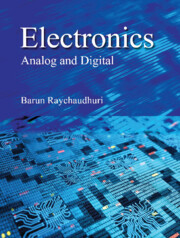Book contents
Summary
The fundamental theories and principles related to digital systems, such as the number systems, codes and the Boolean algebra are discussed in Chapter 13. This chapter presents the practical enactments of those concepts with digital electronic circuits. The basic logic gates, namely AND, OR and NOT and universal gates (NAND and NOR) are illustrated and the working principles of the following types of digital circuits based on the combinations of these gates are explained.
• Circuits executing arithmetic operations: adders and subtractors.
• Circuits capable of comparing the magnitudes of two binary numbers, known as comparators.
• Data processing circuits: multiplexer, demultiplexer, decoder, and encoder.
The different categories of combinations of electronic components for realizing logic gates, known as logic families are also introduced.
Boolean Algebra and Digital Electronics
The algebraic expressions involving Boolean variables (Chapter 13) and their practical realization in terms of voltage levels associated with electronic circuits are two different but interrelated subjects. Boolean algebra is a mathematical theory involving two-state variables and their combinations whereas digital electronics realizes those variables and their algebraic operations in terms of electrical signals of two distinct levels.
English mathematician George Boole (1815–1864) propounded (1854) several symbolic logical expressions involving two states only. The possibility of its practical application was first realized when American engineer Claude E. Shannon (1916–2001) applied (1938) such concept to the analysis of telephone switching circuits, the ‘closed’ and ‘open’ conditions of relay switches being indicated by the two states of Boolean logic. This was the pioneering work on the application of Boolean algebra to digital electronics. Then it got further maturity with the contributions of Karnaugh, De Morgan, and other notable scientists.
A digital electronic circuit is constructed with our known elements, such as diodes, transistors, and FETs along with resistors and capacitors. The difference is that the digital circuits operate with only two discrete levels of voltage for inputs and outputs representing the two possible states of Boolean variables. Digital electronics deals with circuits performing mainly the following operations.
Arithmetic and Logic Operations: An adder circuit can execute binary addition, binary subtraction as negative addition, binary multiplication as repeated addition, and binary division as repeated negative addition. A comparator circuit can decide whether a given binary number is greater than, equal to or less than another.
- Type
- Chapter
- Information
- Electronics , pp. 510 - 556Publisher: Cambridge University PressPrint publication year: 2023



